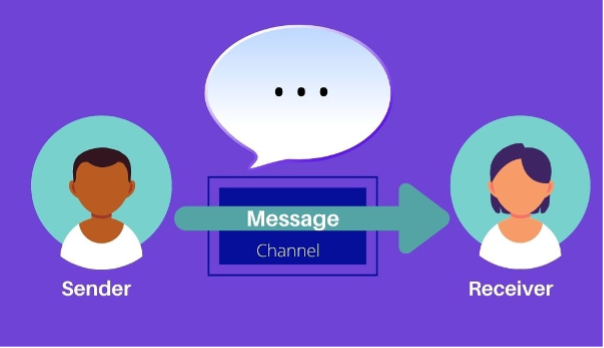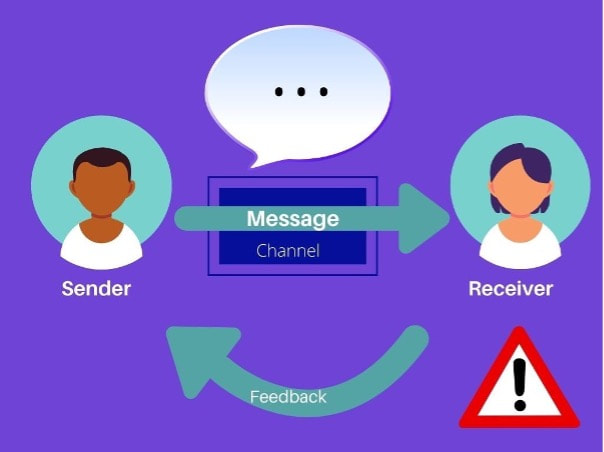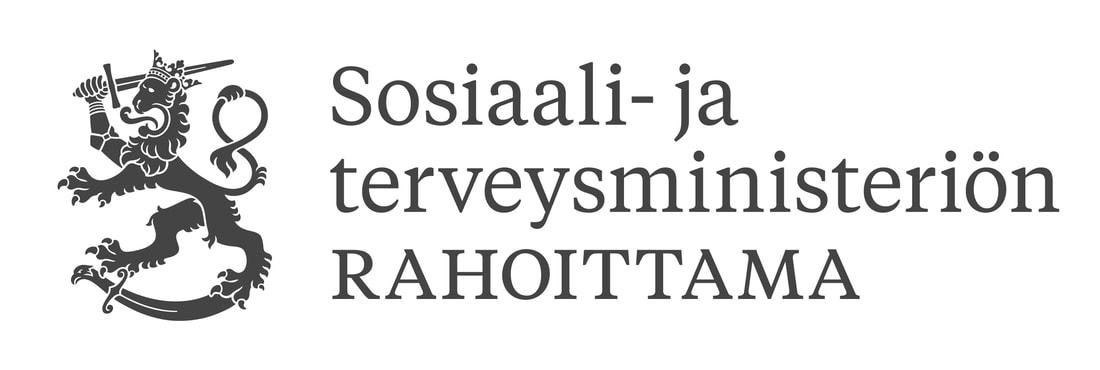There are no facts, only interpretations." In this chapter we will talk about interpretations in communication and how we can avoid misunderstandings in this area in our daily life with our partner.
To start, let us go back to the very basics by defining what communication is. Communication is a process by which information is exchanged between individuals through a common system of symbols, signs, or behaviour, (Merriam-Webster, 2021). Communication can be done through three different channels:
The often-occurring problem in communication is that of meanings. The message sent may not pertain the same meaning and intention to whoever received it. There can be many disturbances to communication, such as interpretation or our own assumptions. The way we interpret messages is shaped by different factors, for instance, current mood, feelings, cultural background, personality, educational background and the way we prefer to communicate.
Especially in intercultural relationships, there can be many misunderstandings simply from interpreting messages differently. In many relationships, be it professional, familiar or romantic, the obstacle seems to be the personal assumptions of the people involved. The sender assumes that what they are saying is received as they understand it. The receiver assumes the message as according to their perception on the matter. The two then believe to be certain and to possess full understanding of what is being communicated, though in reality the two perspectives might not be any further apart. Let us look at a typical example of two spouses: The husband comes home and says, “I am so hungry!”. This is a message in a form of a simple sentence, conveyed through the channel of verbal communication. The wife, who is the receiver of this message, could for example answer with: “Then go make yourself a sandwich.” Additionally, depending on her mood, her personality, her own cultural background, internalised gender roles, and the husband’s non-verbal communication accompanying the statement (tone of voice, posture, facial expressions, etc.) she could easily interpret this in some other way. For instance, some of the following ways: “Oh no, he is hungry, and there is no food. He was expecting me to have food ready.” “Why is it only my job to prepare meals? He is expecting too much!” “I must apologize for not considering that he might have wanted me to prepare something for him.” As we can see from the examples above, she might be triggered with a variety of emotions such as, anger, aggression, guilt or shame. Note also, that this is happening in the receiver even though the sender has not yet explained the original meaning of his message.
Some possible reasons behind his words could be:
This example shows how quickly a sentence as grammatically uncomplicated as, “I am so hungry!", can lead to a conflict, largely due to our individual assumptions. A simple way to avoid these kinds of misinterpretations is by remaining open to the other person’s message when communicating, (i.e., a conversation between two spouses). We must remain mindful of our own perspective and agenda affecting the way we follow and react to the conversation. In other words, practicing introspection is a valuable skill a good communicator remembers to apply to themselves throughout the course of interacting with others. We must also be aware of our understanding being tied -or even limited to- our personal history as mentioned earlier. Without this detail to backgrounds, we will fail to fully understand the other person in how they initially intended their message, (Bohm, 1999). Nevertheless, if we maintain the said openness in the communication, we may discover a deeper and more satisfying explanation to the message through clarification (asking) or elaboration (providing a broader explanation). Openness can assist us to overcome many obstacles when otherwise we might be clouded by our judgemental reactions or self-talk (Hermans, 1996. “The Dialogical Self Theory”;Brinthaupt et al., 2009).
They ended as all great passion do end - by a misunderstanding" Language as a Communication BarrierSome couples do not share the same mother tongue and thus, a word, a phrase or a meaning might be interpreted completely differently between the two. This can happen especially when ambiguity of words, or possible unconscious or culturally maintained connotations, (Baillargeon, 2008) enter the conversation. A person with a certain experience, might perceive a word, -even if used in a positive context- as something negative simply due to a past event. Whatever life or other culturally tied experience the individual has had related to a word, (especially when speaking in a second language) will affect what they associate the word with (negative vs. positive) in their present interactions, (Meara, 1982; Menenti, 2006; Fitzpatrick, 2007). These interactions include conversations with one’s significant other.
To explain this in a broader manner, let us use the word “discipline” as an example. Primarily, according to the Merriam Webster’s Dictionary (2021), "discipline" is defined as:
Secondarily, “discipline” is defined as a “punishment”. Thirdly, it is defined as a “training that corrects, moulds, or perfects the mental faculties or moral character”. Now, most of these above-mentioned definitions (punishment obviously being a negative noun) do not directly describe a negative course of action, but of course allow liberty for the word to be applied either way if so desired. Nevertheless, it is possible that for some individuals the earlier encounters with the word “discipline” could have been negative, containing actions even equivalent to a physical assault, or abuse. The word “discipline” could have been used to describe an unjust situation, (i.e., a teacher physically or verbally abusing a child in a school setting.) and the individual left with an unfavourable, maybe even traumatic impact, (Theoklitou, Kabitsis & Kabitsi, 2012; Clemens et al., 2019). This then affected their perception of the word and any future associations. To others the same word may represent a positive experience, a sort of an ideal situation (e.g., a child seeking to be the teacher’s pet and thus practicing disciplined behaviour in the classroom). It could be also a socially accepted conduct they achieved through applying discipline, (I.e., working diligently for one’s education to gain a societally respected position, such as a doctor). For some “discipline” may even signify a specific dietary regimen as a positive goal of self-improvement and ambition (e.g., athletes). This multi-faceted and complex world of language forms part of what directs our communication. It is therefore important to see how the words we or our partner use (or do not use) can be a product of the unconscious association, of what the words represent to us, (Fitzpatrick, 2007). We must consider our experiences and cultural perceptions even in this context of communication. It also demonstrates how, when unnoticed, the connotations can hinder us from communicating constructively, even with a person as close to us as our partner. Love recognises no barriers. It jumps hurdles, leaps fences, penetrates walls to arrive at its destination full of hope." Humor as a Communication Barrier
Sometimes sarcasm, irony or jokes are used and interpreted completely differently by partners. This counts for non-verbal communication as well. Looking into someone's eyes in some cultures (e.g., many western cultures) is a sign of respect, friendliness and warmth – but in other cultures it might mean mistrust, anger or even disrespect (of hierarchy or of gender). We must be aware of the other persons cultural background and its reflection on their behaviour instead of simply assuming that they view these nuances of communication the same way as us.
What is more, personality differences (which are also interconnected to one’s cultural background) can cause misunderstandings between couples. When an introverted, calm person becomes quiet for a moment, it does not mean he or she is ignoring the other. But for an extroverted, quick-to-talk, partner it might be challenging to see the importance of the silence for their companion. For a social personality type, it can be difficult to learn to develop the patience for the other one's tendency of remaining silent some time. There may be different reasons for the silence, such as introspection, reflection or comfort but ironically there is a chance the more talkative individual of the two views this silence as anger, sadness or as mentioned ignorance. The same happens with the extroverted person who finds comfort in talking and verbal expression (see Theme 5: Love Languages for words of affirmation). This behaviour and form of communication can make the other person scratch their head and wonder why their partner would see a need for so many words and blabber. The introverted one of the couple might ask, why he or she cannot simply meditate on the subject topics silently in their head. Either way, there is a need for understanding the other, in order to get past the initial unattractiveness of the situations. The goal of marriage is not to think alike, but to think together." Summarising, we have established that the key to better communication is openness. This openness can look different depending on the challenge. It can be allowing space for the other to think in silence for a moment, choosing not to view a message through our earlier experiences, or not getting upset when the other one does not want to laugh at our joke simply because of different understanding on humor.
STOPPING FOR CLARIFICATION
It can be hard not to get triggered immediately by something that was said in a conversation. The real challenge is in the choosing to stop and ask for clarification because this requires us not to react based on our reflexes (assumptions), but to review what was said and humbly ask the other.
Examples: “I’m sorry, did I understand this correctly...?” “Could you clarify, please.” “I still do not quite understand, what do you mean when you say...?" “Could you please help me understand...?” “I’m sorry, could you clarify for me if that was meant seriously?” “I’m sorry, why are you laughing?” “Please explain to me, are you still thinking of an answer?” It might feel odd at first to stop and ask, but it is worth it in the end when we gain insight from the other’s perception on the situation. exercise: Interpreting communicationTake a piece of paper and a pen and read the following statements. Write down the first 2-3 possible meanings that come into your mind of these statements. Let your partner do the same.
After you have finished, compare the answers with your partner to see how similarly/differently you interpreted the same statements. When comparing your answers, make the commitment to be specific and clear while communicating as well as asking for clarification if needed. |
QUICK LINKS TO THE COURSE THEMES
FURTHER LEARNING:
To reflect further on different communication barriers, please watch the following videos on communication by Angela Graves, (2020), Amy Scott, (2016) and Fawn Weaver, (2015). What challenges you see in your own communication? Which barriers are the most present between you and your partner? Breaking Down Communication Barriers | Angela Graves | TEDxEvansville |
|
|
© Familia 2024




